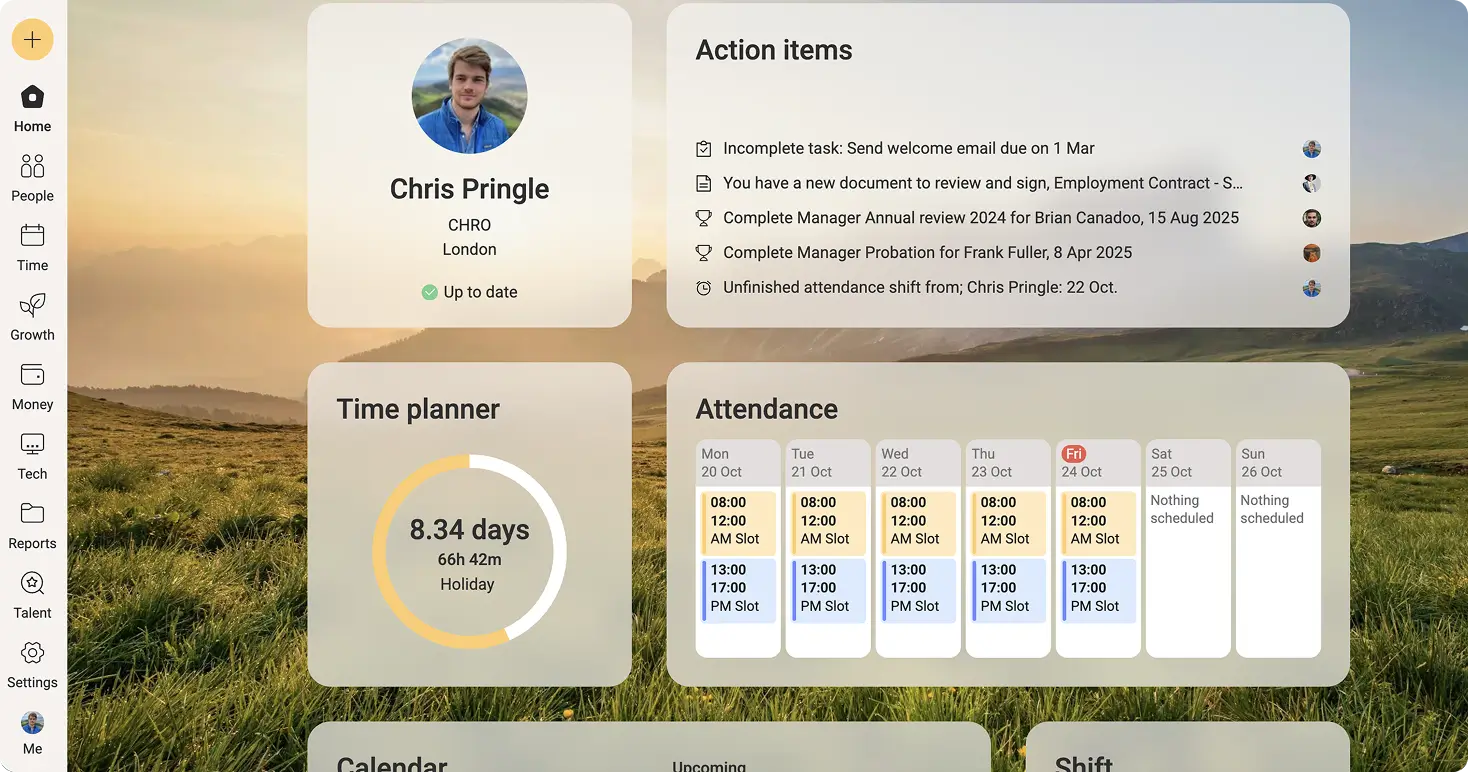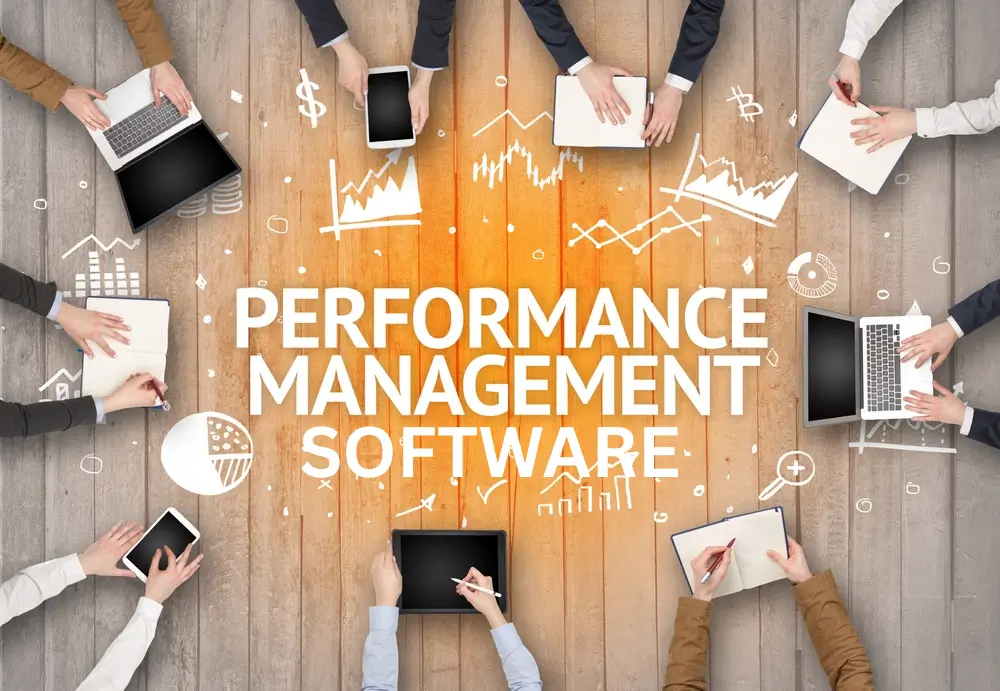How to Choose Performance Management Software (2025 Guide)

There are many performance management tools available today, claiming to be the best and many businesses select them by just checking their features or cost. So, how do you know which one will actually help your team succeed?
This guide will help you know everything about choosing the right performance management software. I will help you know what to look for and practical steps to select a system that truly supports your people and your organisation’s growth.
What Is Performance Management Software?
Performance management software is a tool that helps managers and employees to track goals, progress, and development while staying on the same page. It helps employees align with company goals and managers can easily track performance without manual hurdles and time-consuming paperwork.
We spoke with over 100 managers across different industries here in the UK and found that most struggle to give consistent feedback because they don’t have a clear process. We also found that many managers struggle to recall examples during reviews. That’s why software for performance management has become a necessity for every business in the modern world.
Let me quickly share some key features of a good performance management tool that you should choose:
- Goal setting and tracking
- Continuous feedback
- Automated reminders and review cycles
- Real-time performance insights
- Employee development plans
- Documentation and transparency
- Integration with HR tools
These capabilities of a performance appraisal software save tons of time for HR teams and almost every modern organisation relies on it. According to a Verified Market Research report, the performance management software market is predicted to grow from USD 3.21 Billion in 2023 to USD 7.47 Billion by 2031, which is a huge jump in just a few years.
Why Businesses Need Performance Management Software
Most teams want to do good work, but things often get messy when goals, tasks, and expectations are spread across emails, notebooks, or memory. According to a research, in 2022, millions of workers left their jobs due to a lack of motivation and progression.
It keeps everyone aligned.
We have seen that in many companies, a team might be working hard on something that doesn’t match what the business actually needs. But when a business use a performance software, everyone can see their goals and how those goals support the bigger company plan.
It makes feedback easier and more useful.
Most managers want to give good feedback, but they forget details or wait too long. This software lets managers write quick notes after meetings, track progress, and follow up with clear steps. Instead of saying, “Do better next time,” they can explain what happened and agree on one small change for the next week.
It helps spot top performers early.
Some employees quietly do amazing work but never talk about it. Performance appraisal software shows their progress, achievements, and goal updates in one place. Managers can see patterns—who is improving fast, who handles difficult tasks well, and who needs more help. This stops people from being overlooked and helps the company reward the right talent.
It boosts engagement and growth.
People feel more motivated when they know what they’re working toward and get regular check-ins. Performance review software gives employees a way to track their own goals, share wins and ask for support.
It saves time by removing manual work.
HR teams often spend hours chasing missing review forms or reminding managers about deadlines. With a performance tool, reminders, review cycles, and updates are automated. Instead of doing admin tasks, HR can spend more time helping teams grow.
It turns data into clear insights.
Every goal update, check-in note, and review score creates useful data. The software pulls this together into simple reports.
Employees often feel lost when feedback only comes once a year. Managers we work with now give short, regular check-ins, and engagement scores have improved noticeably.
How to Choose the Right Performance Management Software
Choosing performance management system can feel overwhelming because there are so many options. Most managers we talk with spend 2–4 hours preparing for reviews because they don’t have a single source of truth for feedback and goals. Here’s a step-by-step guide to make the process simple and effective.
1. Identify Your Needs
Before looking at software, know what your company actually needs. List your business goals and current pain points. Are you trying to reduce manual work, improve feedback, or spot top performers faster?
Also, decide who will use the system. HR teams, managers, and employees might all have different priorities. For example, HR may want strong reporting dashboards, managers might care about check-in reminders, and employees want a simple interface to track goals. Understanding this first makes it easier to choose a system that works for everyone.
2. Evaluate Features That Matter
Not all features are equally important. Focus on what actually improves performance management:
- Goal management: Can you set, track, and adjust individual and team goals easily?
- Feedback and check-ins: Does the system allow managers to give timely, actionable feedback?
- Performance review options: Are annual, quarterly, or continuous reviews supported?
- Analytics and reporting: Can you see trends, spot issues, and make data-driven decisions?
- Integrations with HR/payroll systems: Does it connect with existing tools to avoid duplicate work?
For example, one company we worked with ignored gamification features because their priority was real-time reporting. This shows that the most advanced features aren’t always the most useful.
3. Consider User Experience

Even the most powerful software fails if no one uses it. Look for a system that is easy to navigate, intuitive, and mobile-friendly. Employees should be able to log in, see goals, and submit updates without training for hours.
A real-world example: A manager tried a system that had all the features but was confusing to navigate. After two months, only 40% of employees were using it. Choosing user-friendly software from the start prevents adoption problems.
4. Plan for Future Growth
Your business will change, and your software should grow with it. Look for systems that are scalable, with configurable workflows and adaptable goal structures.
For example, if your company doubles in size or adds remote teams, the PMS should handle additional users without breaking reporting or adding complexity. Flexibility ensures the system remains useful for years, not just months.
5. Assess Vendor Support and Reliability
Software isn’t just code—it’s a partnership. Check the vendor’s support and training options. Ask:
- Do they provide onboarding guidance?
- Is their customer support responsive?
- Are they stable and reliable, or likely to disappear in a few years?
- Do they provide thought leadership or updates that keep the software evolving?
We’ve seen companies waste weeks trying to figure out a system with poor support. Choosing a vendor who invests in your success avoids unnecessary headaches.
6. Try Before You Buy
Never commit to software without testing it first. Free trials, demos, or pilot programs let you see how the system works in your actual workflow.
For example, one HR team tested three systems for two weeks with a small team. They realized one system was perfect for managers but confusing for employees. This trial saved months of wasted effort and a costly purchase.
7. Cost vs. Value
Finally, consider the balance between cost and value. A cheaper system may save money upfront but cost hours of extra work or create frustration if it’s hard to use. Look at software pricing, implementation costs, and the time saved by automation and reporting.
In my experience, investing a little more in a system that is easy to adopt and supports your growth often pays off many times over. Don’t just buy software, invest in a tool that actually improves your team’s performance.
Looking for a system that fits all these criteria? Check out our guide to the best performance management software in 2025 to see top options and features in one place.
Key Criteria for Effective Performance Management
A good performance management and appraisal software is more than a list of tools. It’s a way of working that helps employees grow and keeps the whole company moving in the same direction. After seeing how different teams use these systems, these are the criteria that matter most.
- Alignment with Organizational Goals: Everyone should know how their work supports the company’s bigger goals. When goals match, employees see the impact of their efforts.
- Clear Expectations and Objectives: Employees do better when they know exactly what’s expected. Clear objectives prevent confusion and make feedback easier.
- Consistency and Fairness: Reviews should be the same for everyone. Consistent check-ins and fair evaluations build trust and reduce bias.
- Flexibility and Adaptability: Teams and roles change. A good system lets managers update goals quickly to stay useful in real work.
- Continuous Communication and Coaching: Regular, short check-ins help employees improve. Small coaching moments add up and keep people motivated.
Challenges to Watch Out For
Even the best performance management software can fail if a company isn’t careful. These are the main challenges we see HR teams run into—and how to think about them before choosing a system.
Poor adoption due to complex interfaces
A common problem is choosing software that looks powerful but is hard to use. If employees or managers can’t figure out how to log in, update goals, or give feedback, adoption drops fast. One company we worked with had only 40% of staff using the system after three months because it required too many clicks to complete simple tasks. Always prioritize software that’s intuitive and easy to navigate.
Lack of real-time feedback or customization
Some tools only support annual or quarterly reviews, which makes feedback slow and less actionable. Employees don’t get guidance when they need it most. Additionally, if the system doesn’t allow customization, it might force your company into processes that don’t fit your workflow. Look for software that supports quick check-ins, flexible review types, and adjustable templates.
Integration challenges with existing systems
Your performance review software doesn’t exist in isolation. If it doesn’t integrate with HR or payroll management software, you’ll end up with duplicate work or missing data. For example, one client had to manually transfer performance scores to payroll each month, completely negating the time savings they expected. Always check that the system works seamlessly with your current tools.
High costs or data security concerns
Price isn’t just subscription fees. Implementation, training, and lost productivity during the learning curve all add up. At the same time, performance software contains sensitive information, employee ratings, feedback, and personal development plans. Weak security can create legal risks and reduce trust. Verify that your vendor provides proper encryption, role-based access, and data protection policies.
Resistance to change from employees or managers
Even the best software will fail if people don’t use it. Resistance can happen because employees are used to old methods or managers feel it adds more work. To overcome this, communicate clearly, provide training, and involve teams in the rollout. One HR director shared that including managers in the selection process before purchase increased adoption by 60% because they felt ownership over the system.
By anticipating these challenges, you can avoid wasted time, frustration, and poor adoption. Choosing the right system is not just about features—it’s about fit, usability, and support.
Making the Right Choice for Your Organization
Choosing a performance management tool isn’t just about ticking the features box. The right system should match your company’s culture, support your goals and grow with your team. Start by defining your priorities and evaluating how each tool works in real situations.
From our analysis, we place Zelt as a top choice. At Zelt, we combine performance reviews, goal tracking and engagement surveys in one performance management platform, giving full visibility to managers while keeping employees on track. That’s why over 400 high-performing organizations, from Mumsnet to Shakespeare’s Globe, trust Zelt to make performance management simple, fair and effective.
Speak to us to see how Zelt simplifies performance reviews with 360 feedback and AI insights.


